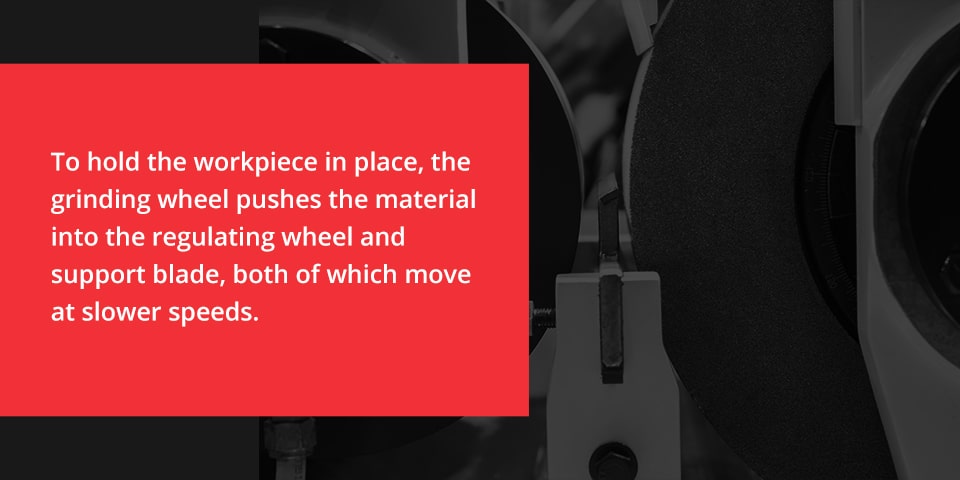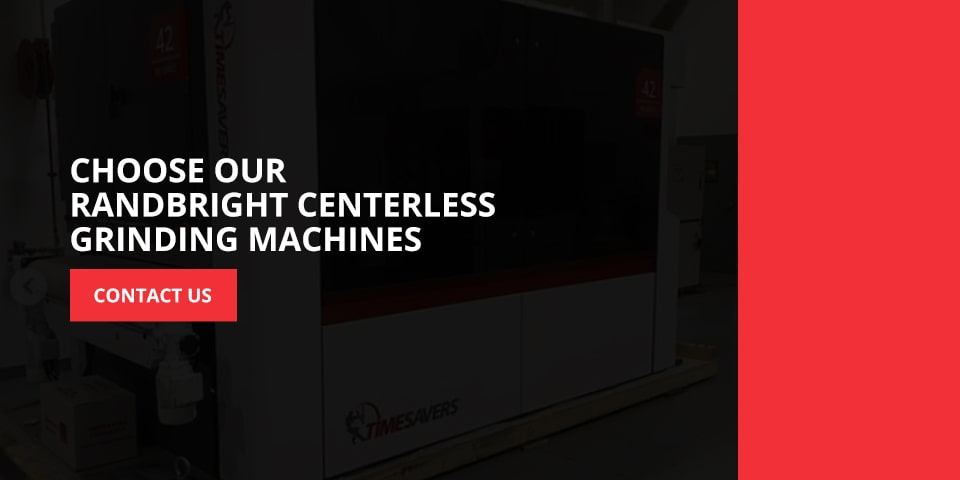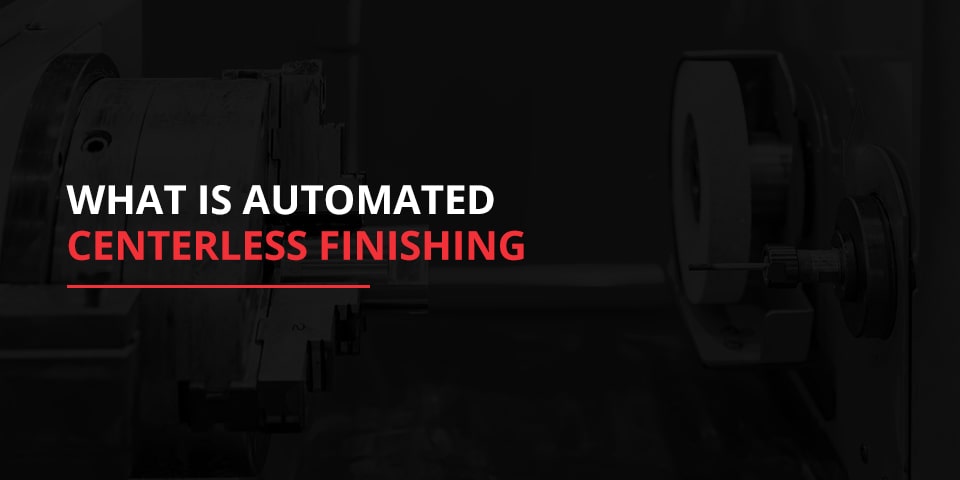What is Automated Cylindrical Finishing
Looking to upgrade and automate your manufacturing systems with a centerless finishing machine? Learn how cylindrical finishing machines work! With unmatched precision and continuous automation, these machines are superior options to manual cylindrical grinding. Especially if you need to process many parts at once, a cylindrical finishing machine can automate results through one of three grinding processes.
With years of experience providing high-quality cylindrical finishing solutions, our Randbright series team can help you learn everything you need to know about centerless grinding!
What Is Cylindrical Finishing?
Cylindrical finishing is a process that removes material from a workpiece through abrasive cutting or grinding. In most cases, the part is round and needs to be ground to a specific flat angle, but you can shape the material into any desired form.
A cylindrical finishing machine consists of two rotary grinding wheels that move at pre-set speeds to hold a workpiece in the center. The grinding wheel on the left applies a downward force to the platform and holds the workpiece in place, while the wheel on the right is the regulating wheel. It moves in response to the different pressures applied to the piece and turns the material for grinding. It’s usually made from rubber-bonded materials to ensure the workpiece is steady. The grinding wheel moves faster than the regulating wheel and removes material to create a smooth and precise grind.
An automated cylindrical finishing machine means the system is autonomous and requires minimal manual assistance. Once you have everything set up, from angles and grinder size, the machine performs independently without workers’ input to complete a full production run.
Automatic cylindrical finishing is an important manufacturing process for dozens of industries, including:
- Military
- Medical
- Industrial
- Aerospace
- Automotive
- Motorsport
- Power generation
- Information technology
- Agricultural and durables
Within each industry, cylindrical grinding can grind a multitude of applications, such as:
- Pins
- Balls
- Shafts
- Pistons
- Needles
- Bearings
- Cylinders
- Camshafts
Any industry that requires cylindricity and cylindrical surface accuracy can rely on a cylindrical finishing machine.

Cylindrical Finishing Process
The basic components of a cylindrical finishing machine are the grinding and regulatory wheels and a work rest blade. To hold the workpiece in place, the grinding wheel pushes the material into the regulating wheel and support blade, both of which move at slower speeds. The regulatory component determines how fast the material moves and, therefore, the grinding speed.
Whatever material piece you’re working with, it should contact all three components at once. This creates a consistent process at high speeds, making automatic cylindrical grinding ideal for high-volume applications. Here’s how the three main working parts function:
- An abrasive grinding wheel grinds the material while also removing burrs and imperfections.
- A regulatory wheel controls the speed of the workpiece and acts as a bumper.
- A work blade supports the workpiece as the grinding component removes material.
The grinding wheel is arguably the most critical component of the system because it must support the material type and surface finish of your workpiece. Cylindrical grinding wheels are available in various widths, diameters, grain types and grit sizes. For example, they can have super abrasive materials like polycrystalline diamond for working with hard metals. Super abrasive grinding wheels are more durable and remain sharper for longer. They produce less thermal conductivity despite high speeds and temperatures, resulting in less grind time, and have longer life spans than wheels made of aluminum oxide.
The regulatory wheel controls the rotational speed of the piece and acts as a bumper to keep the material secure for accuracy. It rotates in the same direction as the grinding wheel but at a slower speed. The work blade is also a supporting component to keep the material steady.
There are also three different types of cylindrical grinding processes, including:
- Through-feed cylindrical grinding: The workpiece feeds through the center of the wheels as the regulating wheel pulls the material through without a separate feeding tool, making it ideal for cylindrical shapes.
- End-feed cylindrical grinding: The workpiece gets fed into the system until it hits an end. After the grinding process, it gets fed out the opposite end, making this method great for tapered materials.
- In-feed cylindrical grinding: The workpiece is manually added to the system and moved around for complex grinding for unusually shaped materials. This method is also called plunge grinding.
Cylindrical finishing holds a workpiece between two rotary wheels moving at different speeds to remove precise amounts of material. This process eliminates complications often found with other machines like lathes and mills when it comes to size, materials and finishes.
Benefits of Automated Cylindrical Finishing
Advantages of incorporating automated cylindrical grinding into your manufacturing process include:
- Longer life span
- Faster loading times
- No resetting equipment
- Better with fragile materials
- Tighter tolerances and no deflections
- Smoother finishes and straighter lines
- Higher production rates for high volumes
The process of loading and unloading pieces is automatic, increasing your output and efficiency and leading to a continuous flow of grinding. Since you don’t have to reset each part manually, an automated machine can push out high-volume material requests with accuracy and speed. You also don’t have to reset the entire machine since the cylindrical grinding operation can finish a full run to save you time and labor costs. Once you have everything set, you won’t have to intervene until the next project calls for different specs.
These automated systems are also advantageous in maintaining tight dimensional tolerances. Since the wheels support the workpiece, there is no material deflection, allowing you to work with heavier pieces.
Finally, automatic cylindrical grinders have a wide processing range that allows them to work on cylindrical and odd shapes as well as less durable materials. Because the regulatory and grinding wheels place no additional pressure on the material, the machine is suitable for working with brittle, soft and fine materials through low tension.
Important Considerations for Operating Cylindrical Finishing Machines
Understanding your project’s production requirements is the most critical consideration when operating a centerless grinder. For example, everything depends on angles. The angle of each wheel determines the required roundness and tolerance of your material. Working with the correct angles also ensures the whole surface area of the grinding wheel is used. When it comes to the regulating wheel and rest blade, they too are critical for precise cylindrical finishing.
Other aspects to think about include:
- What’s the grindability of the material you’re working with?
- Are you keeping an eye on the machine’s coolant levels?
- How are you dressing the grinding wheel?
Coolant is an essential fluid to maintain the system’s temperature while also preventing distortion and other damage. The fluid is also beneficial in the following ways:
- Reduces friction between the wheels and material
- Washes away abrasive chips of metal
- Cleans blades and blade guides
- Lubricates system
Again, the grinding wheel is one of the most important considerations. The key factor is the grinding wheel because it must be suited to the metal parts and their surface finishes. You will want to determine how abrasive the wheel needs to be, including its grit size, grain type and width. Another consideration is the wheel dressing. Rotary and stationary dressing tools are available to help make the wheel round with a flat surface. You also want to create the proper shape into the feed to help pull the material through.
While automated cylindrical finishing is a simple process, it requires precision to produce accurate parts. Avoid working with used and worn machines as they are less precise and require more maintenance.

Choose our Randbright Cylindrical Finishing Machines
As a cylindrical finishing machine manufacturer, the Randbright series delivers simple, efficient and effective solutions for your production line. Our Randbright machines are a prime example of how we advance with technology so you can receive the most efficient machines. With our grinding machines, you can increase production speed and eliminate the need for hand-grinding.
Contact a Timesavers representative online today to learn about our cylindrical finishing machines or view our Randbright products. They’re the perfect upgrade to higher-quality finishes! With several different cylindrical finishing machines to choose from, we have the finishing solutions that you need!

